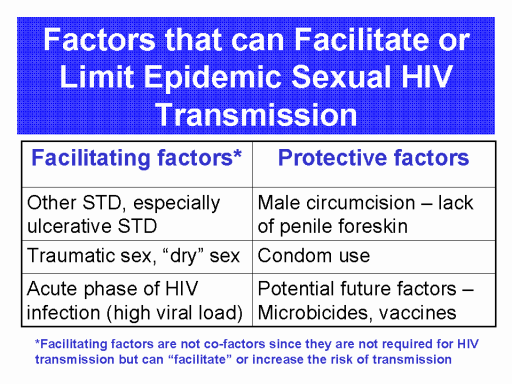| front |1 |2 |3 |4 |5 |6 |7 |8 |9 |10 |11 |12 |13 |14 |15 |16 |17 |18 |19 |20 |21 |22 |23 |24 |25 |26 |27 |28 |29 |30 |31 |32 |33 |review |
 |
Any
factor that can increase the amount of HIV-infected blood or sexual
fluids exchanged during sexual intercourse is a facilitating factor
and any factor that can limit the amount of infected fluids is a
protective factor.
New (incident) HIV Infections - Individuals newly infected with HIV are much more (10-20x more?)
infectious compared with individuals who have passed the acute
period.
Other STI - It is generally accepted
that other STI, especially those that cause ulcerative lesions such
as genital herpes, chancroid and syphilis, increase or facilitate
HIV transmission.
Lack of
Male Circumcision (MC) - Many epidemiological
studies have shown that male circumcision is associated with a reduced rate
of HIV acquisition. Since this hypothesis was first suggested over a decade
ago, increasing documentation to support it has accumulated and the most
recent field trials indicate that it may reduce heterosexual HIV
transmission by up to 60%.
“Dry Sex”
- In many parts of SSA and some areas of
Southeast Asia, some women apply astringent substances into their vaginas to
limit their vaginal secretions. Such
“dry sex” can be much more traumatic and cause lesions in the vagina that
can lead to an increase in HIV transmission rates.
Condom
Use - A high level of condom use can have a
major effect in reducing sexual HIV transmission.
|